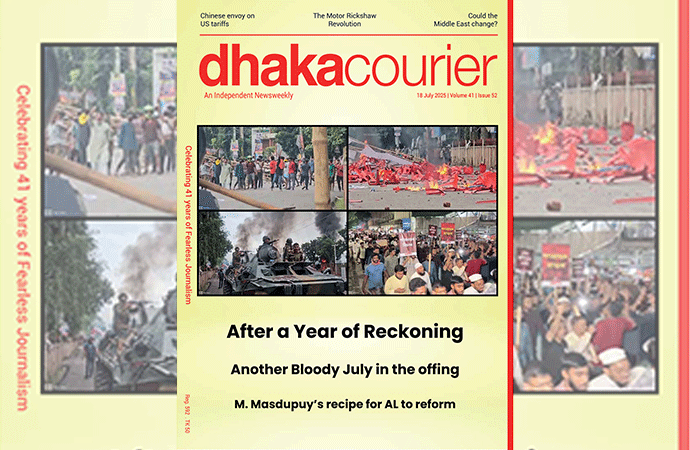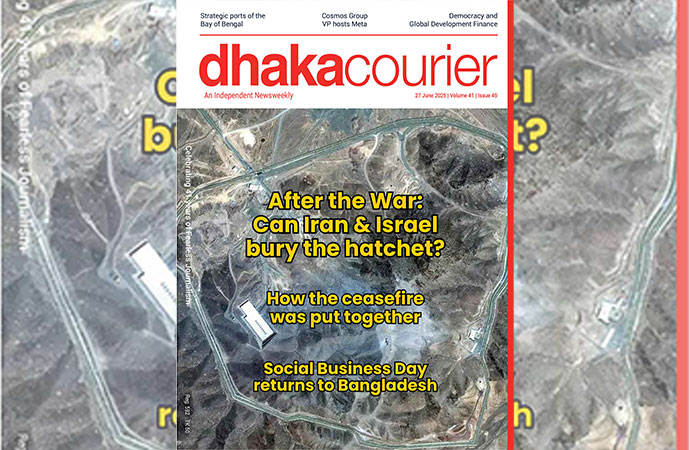Reportage

The most erosive area on the Padma is in its upper section - the Harirampur region. Image: NASA Earth Observatory
Towards the end of last week, our sister newsagency UNB's correspondent in Shariatpur could hardly tell where he was moving in his own home town, as the landscape was being battered out of shape by a famously strong-willed river. He did report though that 5081 families have been rendered homeless in Naria Upazila due to the violent erosion caused by the Padma as it passes through the district in recent weeks.
"We don't want help, we want the embankment, people could make their livelihood by driving rickshaw or three wheeler if there was an embankment here," said mother of two Mahamuda Begum, who has already been displaced four times previously due to river erosion.
Another victim of Padma erosion Azizul Madbar said "My house was 5 km away, this is the fourth time, I have brought down my house and rebuilt for river erosion, I have become depleted. Our rescue is only possible if Prime Minister looks upon us. Otherwise there is no one to save us."
Juwel Bepari of the same area said he and his family were passing their days only half-a-kilometre away from the point at which the river is now, renting a place for Tk 6,000. Meanwhile Monir Bepari said his family has taken shelter one kilometre away at a relative's house, having sold a house they had spent Tk 15 lakh to build for just Tk 17,000.
Sufia Begum of Kedarpur village in the upazila had a large house and owned a shop at the historic but fast-disappearing Mulfatganj bazar, both of which were engulfed by the Padma.
"Within two months our wealthy condition turned into poverty," she said.
The people affected in the region have become listless. With no effective rehabilitation program on the ground reaching the affected people prior to the last couple of days, they were living under the open sky with no roof above them before that.
Though no significant erosion damage has been reported since last Thursday, people of the river banks were passing their days in great fear. Houses here tend to be the makeshift bamboo-and-tin type, all the easier to disassemble before moving to higher ground and setting up again. The main structure rests on a plinth that is raised from the surroundings - indigenous architecture at its most essential. We learn some 200 houses had already been shifted from Banstala area of Naria upazila by the afternoon.
People were seen shifting houses, business establishments, wandering about aimlessly for days. Till the early part of last week, affected people were still telling our reporters that "no one from the government" had inquired about them, or taken any steps for their shelter. The political leaders come to them "only during the election".
They don't want food or money but want only a shed above their head and an embankment, they said.
Within one week different government and private buildings of Mulfatganj Bazar were vandalised. Earlier on Monday night, most of the parts of the new building of Naria Upazila Health Complex went under the Padma water.
Emergency and Exterior departments of the hospital were operating in a residential building of the hospital campus but its main entrance was lost creating disruption in service.
No patients were seen taking treatment there due to erosion fear. Eleven more buildings of the hospital complex were under erosion threat while a crack has occurred in one building, witnesses said. Naria Upazila Nirbahi Officer Sanzila Yasmin said according to the government reports a total of 5081 families has been left without shelter for the erosion in Padma.
"Spending Tk 5 crore, a total of 110,000 Geo bags have been placed on the river banks to prevent the erosion. This has had a miniscule effect," she herself admits.
Executive engineer of Shariatpur Water Development Board Shafikul Islam, in a flurry of frankness said the project to protect river bank now cannot start until the water of the river recedes. The Water Development Board is the body responsible for building embankments.
"Though the prevention of river erosion was not possible in this moment but we were trying to reduce the intensity of the current by putting Geo bags. The project will start after the water decreases," he said.
Deputy Commissioner Abu Taher said some 39 cyclone centres have been prepared for the erosion affected people. By midweek, the affected families were starting to find these, and moving in en masse. Rice and dry food were provided to the affected people. But supplies are still nowhere near sufficient.
The hungry river
More than 66,000 hectares (256 square miles) of land have been lost-roughly the area of Chicago, one of the biggest cities in the US - to erosion caused by the Padma River since 1967. That is according to an August 2018 report published by the NASA Earth Observatory, the arm of the US space agency that is focused on the planet we live in.
The extreme erosion patterns of the Padma are known to have two main causes. First, it is a natural, free-flowing river with little bank protection, other than some occasional sandbags to protect buildings. Second, the bank sits on a large sand bed that can be eroded quickly.
Scientists measure erosion on the Padma River by noting differences in its width, depth, shape, and overall appearance on satellite images. The NASA report, "The Shape of Erosion", compares natural-color satellite images showing the changes to the shape and width of the Padma since 1988. Each "twist and zigzag" is said to tell a different geologic story about the river. The images were acquired by NASA's Landsat satellites: the Thematic Mapper on Landsat 5, the Enhanced Thematic Mapper Plus on Landsat 7, and the Operational Land Imager on Landsat 8. All images were acquired in January and February, during the dry season.
Over the years, researchers have observed an increase in the river's "sinuosity" and "braiding". Sinuosity is the tendency of the river to snake back and forth in an S-shape across its plain. Rivers with high sinuosity are labeled "meandering."
Such rivers are said to evolve as the flow wears away the outer edges, widening the channel. The flow on the inner edge has less energy, allowing more sediment to be deposited there. Sometimes meandering rivers leave scars where the water once flowed, as can be seen in the 2014 image of the Harirampur region. The sediments can come from a variety of sources. One theory suggests that some of the sediments are remnants from a landslide triggered by an earthquake in 1950. Researchers think the coarser material (like sand) took half a century to pass through the river.
Over the past three decades, the river has changed from a relatively narrow, straight line to meandering to braided and, most recently, back to straight. In the image sequence, the most noticeable change occurs upstream near the Harirampur upazila region, which experienced the most erosion. A large flood rose over these banks in 1998, exacerbated by the opening of the Farakka barrage (dam) in India, which released more water into Bangladesh, according to the NASA report.
Further downstream, meandering bends eroded the land near Char Janajat. The river's curves became most extreme from 1995-1996. The curve started to develop in 1992, began to decline in 2002, and has since disappeared.
The report also touches on the construction of the Padma Bridge, and how it may be affected by river erosion. "There are some concerns that erosion could threaten the construction of the bridge, although some researchers believe it could actually stabilize the land and reduce erosion once it is finished," it says.
In recent years, Padma's erosion rates, sinuosity, and braiding have actually decreased. Erosion is said to have slowed as the meandering bends disappeared due to sedimentation and something called "chute cutoff"-when the water flows across the land instead of following the curve of the river. "But that does not mean the area is free from erosion," the report concludes.
Additional reporting, images by UNB Shariatpur correspondent.

























Leave a Comment
Recent Posts
The Northeastern Question
When secessionist movements sprang up across the Eastern European part ...
Trump’s Tariff: How far should ...
Will Bangladesh manage to get a last minute reprieve on its 'Trump tar ...
Rivers, Peaks, and Expressions – My Experience at th ..
What lies behind the alarming spike in violence agai ..
A Himalayan choice
Twenty Palestinians were killed at a food distributi ..